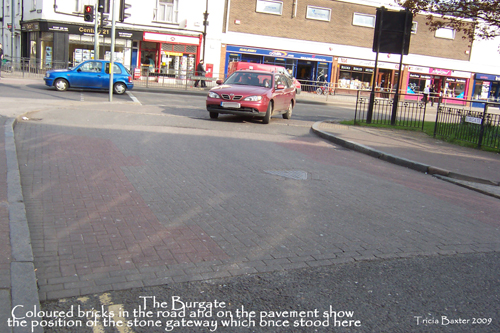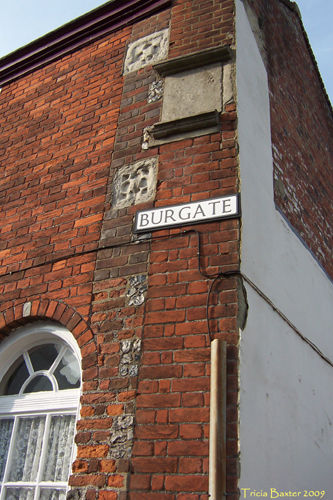
h![]()
~ BURGATE / ST. MICHAEL'S GATE ~
CANTERBURY
Erected in 1475, taken down 1781 - 1822
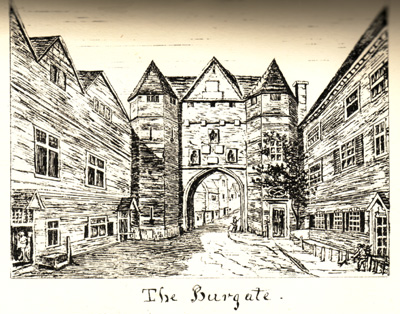
"THE BURGATE" A drawing from Canterbury in the Olden Time by John Brent F.S.A., 1879
"It is intended to widen the entrance to Canterbury, from the Sandwich and Deal road, by taking down the remaining tower of Burgate, with the adjacent buildings. This tower was rebuilt of brick, with stone-quions, in 1475; the names of some of the benefactors being still legible on the side. Among these, is John Franyngham, mayor in 1462, &c. It was an unsightly structure, as the central part had been taken down in 1781, and the southern tower afterwards." NMM 1821
1502. It is in contemplation to rebuild St. Michael's gate. The accounts mention a payment of 8d. for engraving one iron wherewith to mark murderers. HT
Burgate Ward, so called from the Gate opening into it, called Burgate, or St. Michael's Gate, from the Church adjoining to it, dedicated to that Archangel. By this Gate lies the Road to Sandwich, and those Parts from this City, as also to St. Martin's.... MBA 1738
A view of No. 3 Burgate above showing pieces of the old Burgate in the building
"The older medieval way through Canterbury, from west to east, made a slight detour to sweep by the cathedral, and the earliest eastern gate was that of Burgate at the end of the street of that name. It was at one time called St. Michael's Gate from a church of that dedication which used to stand near it. It was rebuilt of brick in 1475. The gateway and one tower were cleared away to give greater space towards the close of the eighteenth century, and in 1822 the north tower was taken down to secure the further widening of the street. Three stones bearing the names of John Franingham, John Nethersole, and Edmund Minot were at that time preserved and placed in the wall close by, they were chief benefactors to the good brickwork of 1475." CC, 1905
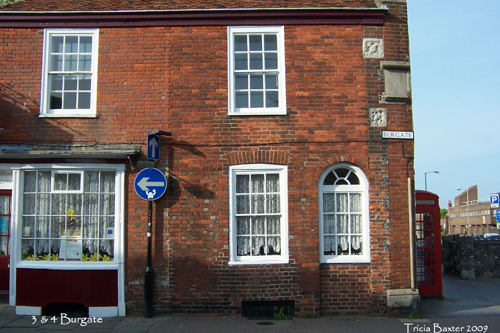
"Burgate is on the road to Sandwich, Deal, and the Downs; new built, says Somner, about 1475, with the names of John Franingam, John Nethersole, and Edmund Minot upon it as principal benefactors to the work; but they are not legible from the ground." 1777 WG
"Burgate was formerly called St. Michael's gate, from a church of that name once near it. This gate was rebuilt of brick, with stone quions in 1475; the principal benefactors whose names were on it being John Franingham, John Nethersole and Edmund Minot. It was pulled down a few years ago to make the passage more commodious; the high road from Sandwich to Deal leading through it. John Frenygham esq. mayor of this city in 1461, gave by his will, among other benefactions, 201. to the repairing of St. Michael's gate, or paving the Bull Stake." HT 1793
Burgate formerly called Boroughgate, or St. Michael's Gate, was, in 1781, so much decayed that it was entirely removed, to improve the street to which it gave it's name. 1838 directory
Burgate was formerly called St. Michael's gate, from a church of that name once near it. This gate was re-built of brick with stone quions in 1475. It was pulled down to make the passage more commodious, the high road from Sandwich to Deal leading through it. 1847
"Formerly called St. Michael's Gate, from a church once near it. This gate was rebuilt of brick in 1475; the north tower remained until 1822, when it was taken down and the street widened. Three stones bearing the names of John Franingam, John Nethersole, and Edmund Minot upon them were preserved, and placed in the wall opposite where the gate stood." GG c. 1890
1543 "Nine load of stone was obtained from the suppressed monastery of St. Augustine. The material cost the city nothing, but 13 1/2d. was paid for carriage, and two labourers were also paid for their four days of destruction." (materials for the repair of Burgate) 1905
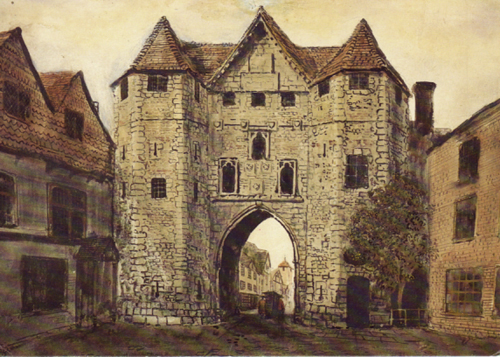
A postcard from my collection of "THE BURGATE"
Reports 1548-49 - For farther repairs at Burgate, farther depredations were committed on the masonry at St. Augustine's. Also the Treasurer of the newly reformed Cathedral sold stone to be broken up for mending roads. The town walls were repaired by twelve Frenchmen, prisoners in Westgate, an English foreman overlooking them.
